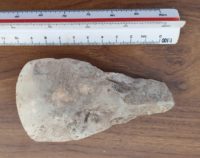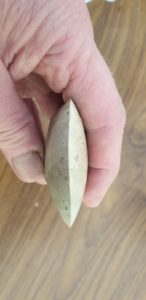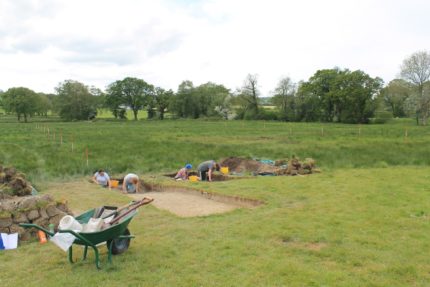 A rare highly polished stone axe head has been unearthed in an excavation in Llanllyr, central Wales. A team of staff and students from University of Wales Trinity Saint David (UWTSD) working on a module that allows undergraduates to get fieldwork practice in archaeology excavated mounds believed to date to the Neolithic era (4,000-6,000 years ago). Most of the artifacts recovered in this area date to the Middle Ages, so the discovery of a Neolithic stone axe in excellent condition was a happy surprise.
A rare highly polished stone axe head has been unearthed in an excavation in Llanllyr, central Wales. A team of staff and students from University of Wales Trinity Saint David (UWTSD) working on a module that allows undergraduates to get fieldwork practice in archaeology excavated mounds believed to date to the Neolithic era (4,000-6,000 years ago). Most of the artifacts recovered in this area date to the Middle Ages, so the discovery of a Neolithic stone axe in excellent condition was a happy surprise.
Dr Martin Bates, a geoarchaeologist at the University of Wales Trinity Saint David has been jointly leading the team. He said:
“Running an excavation like this is an important part of our teaching here at Lampeter and giving our students the opportunity to gain the skills an archaeologist needs is very important. When we began our excavations we did not anticipate finding Neolithic artefacts so this is a bonus for the team. Hopefully, we can come back next year with a new group of students and continue our investigation of this important piece of Ceredigion’s history”.
Joe Neal a second-year student in Archaeology was the lucky student who found the stone axe. He commented
“It’s a great find for us, I couldn’t have hoped to find anything better. This is my first dig and the first time I have found anything, so this is great”.
Dr Ros Coard, Senior Lecturer in Archaeology at UWTSD, added
“The University of Trinity Saint David has run excavations at the Llanllyr site over a number of years but mostly found later medieval material, so to find a much deeper pre-history is exciting and broadens our understanding of the Aeron Valley and this part of Ceredigion. It is a most unusual and unexpected find certainly warranting further exploration of the area”.
 The mounds are shallow bumps in marshland now, but in the Neolithic they were dry ground. Evidence of human activity, namely flint knapping artifacts, have been found on the mounds. A whole axe head has never been found here before, and this one was very finely ground and still has a nicely polished edge. This took a great deal of work to produce and is still in excellent condition. It’s surprising that it would have been deliberately discarded on the mounds. The wooden handle it was probably hafted with is gone.
The mounds are shallow bumps in marshland now, but in the Neolithic they were dry ground. Evidence of human activity, namely flint knapping artifacts, have been found on the mounds. A whole axe head has never been found here before, and this one was very finely ground and still has a nicely polished edge. This took a great deal of work to produce and is still in excellent condition. It’s surprising that it would have been deliberately discarded on the mounds. The wooden handle it was probably hafted with is gone.
The team has collected core samples of the landscape. These will hopefully allow researchers to create a layer map of vegetation that can help date finds like the stone axe.
